Modelling Player Skills in Rocket League through a Behavioural Pattern Mining Approach
Authors :
Sayyed Johar
Address :
Dept of AIML, JNNCE-Shivamogga, Visveswaraya Technological University, Belagavi-590018
Abstract :
In the gaming business, esports, also known as competitive gaming, has ushered in a new age that has brought up some innovative issues. One of these challenges is determining the level of player competency based on their plans and talents. Using game traces from Rocket League, a one-of-a-kind "soccer with rocket-powered cars" game, this investigation focuses on the automatic recognition of skill shots, an essential component of player performance. Challenges arise for classic pattern matching algorithms due to the unique characteristics of each skill performance. A Player Skill Modeling through Data-Centric Patterns(PSM-DCP) strategy that uses pattern mining and supervised learning techniques offers a solution to this issue. To highlight the potential of our system for player modeling shows that it can efficiently detect a wide variety of Rocket League abilities and shots. Also confirm the efficacy of this technique by conducting a comprehensive set of tests, which reveals that it is able to effectively differentiate and evaluate skillshots. The study results have a wide range of implications for various applications within esports. These applications include the improvement of match-making algorithms, the provision of assistance to game commentators in the form of insightful assessments, and the development of learning systems that are intended to improve player abilities. This study not only tackles the unique context of Rocket League, but it also offers a framework for exploiting data-centric techniques in esports analytics. This allows for additional developments and applications in competitive gaming, which opens up new paths for possibilities.
Keywords :
Esports; Competitive Gaming; Player Competency; Skill shots; Rocket League; Pattern Mining; Supervised Learning; Gaming Analytics; Match-Making Algorithms; Game Commentary.
1.Introduction
The world of competitive gaming, known as esports, has rapidly gained popularity and recognition, with online and offline tournaments attracting players of all skill levels[1]. Games offering substantial cash prizes and garnering large audiences on live streaming platforms have become a significant part of the gaming industry[2]. Designing games that can be played competitively as esports presents a challenge for game developers, as they must strike a balance between game difficulty and the enjoyment of players[3]. A successful esports game should be challenging enough to showcase extraordinary skills by professional gamers, while also providing an engaging learning curve for casual players.
One of the key aspects of esports is the need for players to compete against opponents of similar skill levels[4]. Matchmaking systems typically rely on scoring mechanisms like ELO ratings based on wins and losses, but they often lack detailed information about a player's skills and strategies. Understanding a player's level of expertise and tracking their progression is crucial for enhancing the gaming experience[5]. Analyzing game logs can reveal behavioral patterns that correspond to specific strategies and skills employed by players during gameplay
In this context, our focus is on Rocket League, a popular esports game described as soccer, but with rocket-powered cars. Launched, Rocket League has amassed a large player base and gained recognition in the esports community[6]. Players control cars on a soccer field and aim to score goals, requiring precise control and mastery of various skills. The game's simplicity in rules is contrasted by the complexity of car control, which demands extensive practice to excel[7]. Even years after its release, new playing styles and skills continue to emerge, influencing professional gameplay and captivating audiences[8].
Game logs in Rocket League capture not only competitive matches but also training sessions, providing a wealth of data for analyzing player performance and skill development[9]. This research aims to leverage this data to automatically detect skillshots – unique and impactful maneuvers executed by players during gameplay[10]. Identifying skillshots from game traces poses a challenge due to the uniqueness of each occurrence from a data perspective[11]. Therefore, advanced data analysis techniques are essential for accurately detecting and categorizing these skills[12]. This research makes three contributions:
- To explore the development of an interpretable prediction model for detecting skillshots in real-time Rocket League game logs, leveraging a dataset manually annotated with skillshots and behavioral patterns guided by PSM-DCP strategy.
- To investigate using discriminant pattern mining and supervised classification, following the PSM-DCP strategy, to automatically identify and classify Rocket League skillshots.
- To examine how sophisticated data analysis approaches may improve player profiling, game analytics, and esports by better understanding Rocket League player talents and tactics.
A summary of the research is provided below. In Section 2, the current literature and study techniques are thoroughly examined. The research strategy, methodology and processing procedures are detailed in Section 3. The results analysis is covered in Section 4. Part 5 explores the main conclusion and Future work.
2. Literature Survey
Monsma [13] showcased the Rocket League, a wildly successful esports game that has amassed a devoted fanbase of more than 90 million individuals. Professional teams must continuously strive for performance improvement if they want to remain relevant. To provide the groundwork for data-driven performance in Rocket League, a framework has been built to apply best practices in notational analysis. The goal, components, and success criteria of a notational analysis system are defined by the framework. Through discussions with seasoned researchers in esports performance analysis, it has been tested and refined, and areas of attention have been highlighted for future revisions.
Kovalchik and Stephanie [14] discussed how the explosion of player tracking data has changed the game in a number of sports by opening the door to new ways of measuring performance and assigning points for individual plays. Sports may expand analytical methods in numerous fields, as shown in this study, which emphasizes major contributions from statistical and machine learning methodologies. But it also talks about the methodological problems with monitoring data use in sports, which are still there. Sports have the ability to be a testing ground for new analytical methods, as this study has shown.
Ke et al. [15] displayed the standardised process of building machine learning models for basketball rosters(MLM-BR) ; the NBA and the WNBA have collaborated to create a new framework. The system classifies players and builds a model of the squad using principle components analysis (PCA) and a basic neural network. With it comes a rating system that takes into account things like player performance patterns and their ability to execute under duress. Using various weighting techniques, the framework found ten player groups, four of which were deemed elite.
Ziyi et al. [16] suggested a technique of comparison analysis for the purpose of assessing the trajectories of several agents in ball games. A trajectory analysis with neural network (TA-NN) strategy that is based on attention mechanism is used in order to identify unique segments in the trajectories of classes that have been provided. Through the highlighting of segmented trajectories and the identification of variables that are connected with specific labels, the approach makes it possible to comprehend the distinctions that exist across classes. By comparing baselines with effective/ineffective attack labels with NBA datasets, the efficacy of the system was validated and confirmed.
Bialecki et al. [17] suggested that esports offers a great amount of data availability, which makes it available to the scientific community. Now available is a dataset consisting of 17930 game-state files that was processed into 55 "replaypacks" from StarCraft II competitions. For statistical and machine learning modeling tasks, as well as for comparisons to laboratory measurements, these data are absolutely necessary. There is potential for the dataset to be used in artificial intelligence, machine learning, psychology, and sports-related research.
Chessa et al. [18] demonstrated a weighted complex network approach(WCNA) to the problem of identifying basketball player communities on the basis of their performances. A sparsification method is also used in order to get rid of weak edges. By calculating the ideal community structure of the "giant component" at each edge removal, modularity and compactness are maximized to their full potential. The normalized mutual information serves as a confirmation of the sparsification transition, which ultimately leads to the optimal number of communities and the most optimal distribution of nodes. In order to facilitate data-driven decision-making in basketball, the concept is used to the regular season of the NBA.
Kleinman and Erica Michelle [19] provided a summary of In high-impact fields like as education, training, and health, complex games that include several right techniques and uncertain consequences are becoming more popular. Because of their high learning curves, however, they are inaccessible to a large number of players, which results in a reduction in diversity among professional circles. Through the use of the Cyclical Phase Model of Self-Regulated Learning, this study investigates how players acquire the skills necessary to play and become proficient in increasingly difficult games. Moreover, it offers empirical insights for the creation of computational support tools for learning, as well as an expanded knowledge of learning and mastery in complicated gaming. By contributing to the development of more accessible and effective high-impact technologies, this study helps to make complicated games more accessible.
Mountifield et al. [20] provided a summary of the field of sport analytics is expanding rapidly within the sporting sector. It provides teams and organizations with the ability to enhance their performance and make well-informed choices on their performance. A dearth of algorithms and statistical approaches that are in the public domain has arisen as a consequence of the increasing competitive goals of sport analytics. It is becoming increasingly popular and a sphere of common knowledge, despite the fact that there are many who say that its use is based on the self-interest of organizations. A literature overview on statistical aspects, performance optimization, theoretical frameworks, and applications of sport analytics is presented in this chapter. The purpose of this study is to demonstrate that sport analytics is more than simply alchemy in the entertainment sector.
3. A Player Skill Modelling through Data-Centric Patterns(PSM-DCP) strategy
By integrating the Behavioral Pattern Mining Approach and the Player Skill Modeling through Data-Centric Patterns technique, the study that is being offered has the objective of enhancing the detection and categorization of skillshots in the gaming of Rocket League. The result of this will be a system that is more thorough in terms of spotting player techniques. In order to improve the precision and dependability of skillshot identification, more validation and refinement will be carried out via the use of experiments and studies. Improving player profiling, boosting game analytics, and providing assistance for the creation of new game modes based on skill execution are all things that will be accomplished via the use of the integrated approach in a variety of esports scenarios. The findings of this study will give players, commentators, and game developers with useful information that will help them navigate the ever-changing world of competitive gaming.
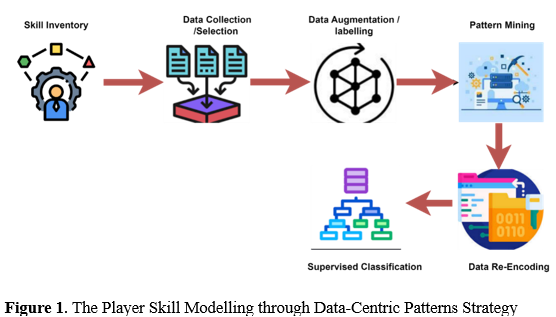
In figure 1 ,Rocket League player skill modelling utilizing a Behavioral Pattern Mining Approach is the main emphasis of the research. One important part of the process is collecting expert information on popular skillshots. Some examples of these skillshots include the Ceiling Shot, Power Shot, Waving Dash, Air Dribbling, Front Flick, and Musty Flick. The next step is to gather and choose relevant data in order to construct an analysis dataset. This dataset is then enhanced and annotated by hand with skillshots to provide labelled examples for model training. The annotated dataset is mined for behavioural patterns that firmly define skillshots; these patterns stand in for the distinct series of actions and behaviours linked to various skillshots in the game. To prepare the data for training the model to predict skillshots based on unobserved player trace segments, the detected behavioral patterns are re-encoded into the starting dataset with the extracted patterns. It all comes down to training the model to predict skillshots in real-time Rocket League game logs using supervised classification approaches. Improved game statistics, better player profiling, and new insights for the esports community are all goals of this methodical strategy.
a. Skill Inventory for PSM-DCP
Important skillshots can only be understood and categorized via the Skill Inventory stage of the Rocket League player skill modeling process. Power Shot, Roof Shot, Front F flick, and Musty Flick are some of the prominent skillshots that should be first identified and then compiled into a complete list. Both individual and team success in games are heavily dependent on these abilities. The Ceiling Shot calls for deft timing and control as the ball is struck high into the air in the direction of the opponent's goal. A Power Shot is a very strong shot that aims to score by hitting the ball with tremendous force. To avoid obstacles or get into shooting position, you may use the Waving Dash, which entails a rapid zigzag pattern. Proving one's mastery of the air and the ball requires the ability to dribble while in the air. When passing or shooting, the front flick is a frequent technique that involves swiping the car forward to move the ball in a desired direction. A difficult tactic that may be used to surprise opponents or score creatively is the Musty Flick, which involves particular vehicle rotations.
b. Data Collection and Selection
When a Rocket League match is across, the gaming client will save a replay file for future reference. Each contains information that provides context about the vehicles and the ball. It is made up of these information. This gives the player the ability to play the game again using the engine of the game at any point in time. Replays may be parsed1 in order to extract hundreds of variables out the ball and players. These variables include a speed vector, a locations vector, a rotations vector, and a rotation speed vector. Each of these vectors is formed of three dimensions, and this process is repeated several times per second for every person on the field which includes both players and balls. A vast number of game states are produced as a consequence of this, each of which contains values for a group of variables, Time is equal to 1.298, Px is equal to 7578, Pz is equal to 4678, Pvx is equal to 511, Pvy is equal to 555, Pvz is equal to 7863, Prx is equal to 6365, Pry is equal to 5665, Prz is equal to 6, Ballx is equal to 568, Bally is equal to 8663, Ballz is equal to 665,...,...i, where Pi represents the location of the automobile in dimensions i, Psi is equal to its velocity, and etc.
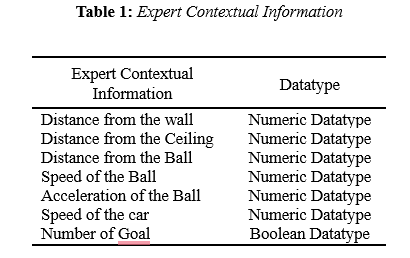
The amount of characteristics that we have to deal with may be reduced via the use of feature selection and engineering, which is accomplished with the assistance of professional expertise. As an instance, the information on the location of a permanent boost pad, which is an object on the field that provides players with a boost, will not be of any use in classifying the activity that the player is executing. Table I contains a list of the information that is pertinent to the context. By retro-engineering the locations of the walls and ceiling in replays of games that have previously been played, it is possible to simply calculate the wall the distance, ceiling distance, and ball distance by utilizing the exact positions on the ball and players. Information that is contextual Type of data Distance from the wall (not the backboard) Horizontal and vertical distances Ball distance expressed in numerical form Number of the ball's speed Acceleration of the ball in numerical form Number of miles per hour Goal Scored Boolean with a Numeric Value
c. Data Augmentation and Labelling
Particularly in the research on Rocket League player skill modeling, data augmentation is an essential step in ML models. In order to make the model better and more generalizable, it is necessary to add more data to the dataset. Two crucial parts of the procedure are the integration of player inputs and the succession of contextual information retrieved from game replays. By merging the ambient context of the game's state with the player's unique actions, this integration offers a holistic perspective of gaming dynamics. Sequences are filtered in the data enhancement process according to the similarity of subsequent states, which improves computing efficiency and filters out unnecessary information. As a result, subsequent analysis and pattern retrieval will only take into account relevant and separate states.
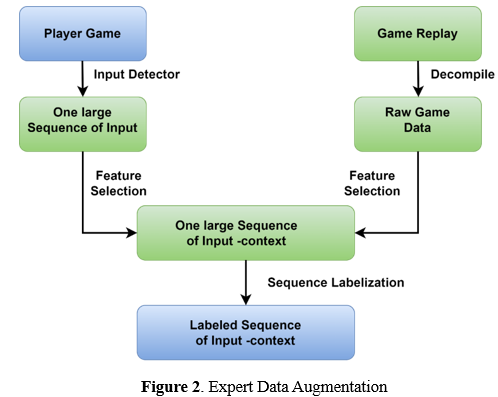
In figure 2, Data augmentation has many uses: it makes models more resilient by adding noise to the training data, it shows how different players play by giving the model more examples of gameplay, and it makes features more accurately represent the data by giving the model a more complete set of features to work with.Finally, data augmentation is crucial for getting the dataset ready to train the model to correctly identify and categorize Rocket League players' abilities. Data augmentation improves the algorithm's learning capacity and prediction accuracy in real-time gaming situations by adding varied and useful samples to the dataset.
d. Pattern Matching
According to the research, pattern mining is an essential part of the process for Rocket League skill modeling. Finding the essential sequences of behaviors that define individual skillshots is the goal of this approach, which entails mining the annotated information for behavioral patterns. Finding these patterns will help the model learn to correctly identify and categorize skillshots, which will aid in creating a prediction model that can be understood by players to detect abilities in real-time gaming.The first step in pattern mining is to get the annotation dataset, which includes labelled examples of Rocket League skillshots executed by players. These instances represent the player's actions and behaviors, and they are linked to several skillshots, including Ceiling Shots, Power Shots and more. By analyzing these sequences, pattern mining hopes to identify recurrent patterns that point to certain skillshots.When expressed mathematically, pattern mining looks like this:
P={p1,p2,...,pn} (1)
In equation 1,The collection of extracted patterns is denoted by the character P. A pattern that is unique to the set is denoted by the integer pi. A total of n patterns have been retrieved from the data. The process of identifying frequent and repeating patterns in the activities of players inside a game is referred to as one of the methods known as pattern mining. It entails studying the sequences of activities included within the dataset, looking at the temporal order of those actions and the links between them within the context of the gameplay of the game. The program is able to recognize patterns that are typical of certain skillshots by using data mining approaches such as sequence mining algorithms. This allows the system to learn and detect these patterns while it is in the process of categorization. These trends are then displayed in a structured way. During the process of evaluating the extracted patterns, the frequency, importance, and discriminative strength of the patterns are taken into consideration. Patterns that are highly informative and representational are given priority. For the purpose of gaining significant insights on player performance and gaming tactics in real-time settings, this technique assists in the discovery of the underlying habits that define player abilities in Rocket League.
e. Data Re-Encoding
In the process of data re-encoding, the initial dataset of actions taken by players or skillshots is transformed into an organized form that may be used for predictive activities. It is required to do this transformation in order to present information in a manner that enables the model to acquire knowledge and generate forecasts based on the patterns and characteristics that have been collected. The process of re-encoding often includes the creation of binary features that represent the presence or missing of certain sequences or patterns within the dataset.The following is a mathematical representation of the process of re-encoding data: The equation for D is as follows:
D = d 1,d 2,...d m (2)
In equation 2, The re-encoded dataset is abbreviated as D.In the context of the dataset, the symbol di represents a single data instance.In the re-encoded dataset, the full number of data instances is denoted by the letter m.
The process of re-encoding entails the creation of binary characteristics for each extracted pattern or sequence of events that has been detected via pattern mining. On the other hand, if the pattern is not present in a given data instance, these characteristics assign a value of 0 and assign a value of 1 if it is present. It is because of this that the model is able to connect certain patterns with various skillshots. In order to simplify the representation of the data and have it ready for classification tasks, the initial dataset is converted into a binary transactional format. On the basis of the re-encoded dataset, an analysis is performed to determine which characteristics are the most informative and discriminative for skillshot categorization. Techniques for feature selection may be used to minimize the dimensionality of the data and concentrate on the patterns that are pertinent to the training of the model. The re-encoded dataset is then prepared for classification, which is the process by which the model makes predictions about the skillshots that players do based on the patterns and characteristics that have been retrieved.
f. Classification
With the goal of constructing a prediction model that is capable of reliably classifying skillshots in real-time gaming settings, the classification procedure in Rocket League entails training an algorithm for machine learning using a dataset that has been re-encoded. In order to understand the link between recovered patterns and skillshots, the approach requires first dividing the database into training and testing sets, and then training a model on the training data. It is possible to make use of well-known classification techniques such as Decision Trees, Random Forests, supported vector machines, or Neural Networks. After that, the model that was trained is assessed using the testing data in order to see how well it performs in terms of properly forecasting skillshot numbers. After that, the model is able to make predictions about skillshots in real-time gaming settings, which provides significant insights concerning player performance and tactics involved in games. Within the framework of the approach for modeling player abilities in Rocket League, the re-encoding of data and categorization of data are both crucial components.
4. Experimental Results and Analysis
A approach for modeling Rocket League player talents is the subject of the research. In order to train a prediction model for skillshot recognition, it creates a dataset containing game states that are tagged with skillshots and enhanced with player actions. Top pattern for each class of skillshots are identified by the model using discriminant data mining and supervised classification. A Decision Tree technique is used to train the model since it is easy to understand and use. Results demonstrate excellent skillshot classification accuracy using SeqScout's top patterns as useful features. In order to improve the model's performance, the research highlights the significance of choosing features and pattern quality. Researchers can grasp the fundamental trends and principles utilized for skillshot categorization thanks to the Decision Tree method, which also highlights the model's interpretability. The research demonstrates the practicality and efficiency of this data-driven approach by validating the methodology's ability to recognize skillshots from Rocket League game traces.
a. Performance metrics for PSM-DCP
A number of criteria are used to assess the accuracy of the Rocket League skillshot detection and categorization prediction model in this article. The accuracy of a model is defined as its whole efficacy in detecting and classifying skillshots from extracted patterns, including its precision, accuracy, and recall. Important measures include the following: classifier type, accuracy, recall, F1 score, precision, and iterations or patterns count, sequence generalization parameter. A model's accuracy is the degree to which its forecasts are generally right, while precision is a numerical measure of the fraction of positive predictions that actually come true. A model's recall indicates how well it can identify skillshots. As a fair measure of the model's efficacy, the F1 score takes accuracy and recall and harmonically means them. An analysis of the pattern mining process's effect on the model's performance may be done by plotting the number of patterns or iterations. A plot of the sequence generalisation parameter may be used to study its impact on classification accuracy and pattern quality. Different classification techniques may have their supervised learning classifier types charted to see how they perform.
In figure 3,Trajectory Analysis - Neural Network (TA-NN), Machine Learning Model - Basketball Rosters (MLM-BR), Weighted Complex Network Approach (WCNA), and Player Skill Modeling through Data-Centric Patterns (PSM-DCP) are some of the techniques that have been used to detect skillshots in Rocket League. These techniques have been evaluated for their accuracy, precision, recall, and F-measure values. According to the accuracy numbers, the proportion of cases that were properly categorized out of the total number of occurrences is shown. When it comes to forecasting skillshots, greater accuracy numbers suggest a larger proportion of right predictions overall. The PSM-DCP approach regularly exhibits the best accuracy over a wide range of pattern numbers, exceeding all of the other techniques.
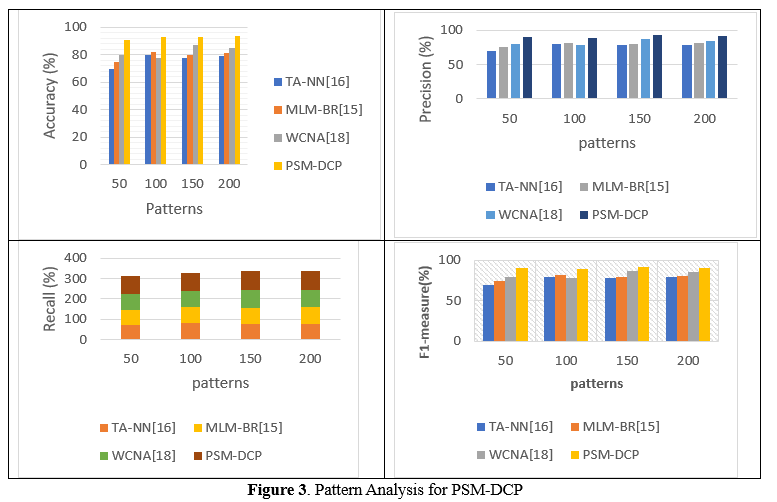
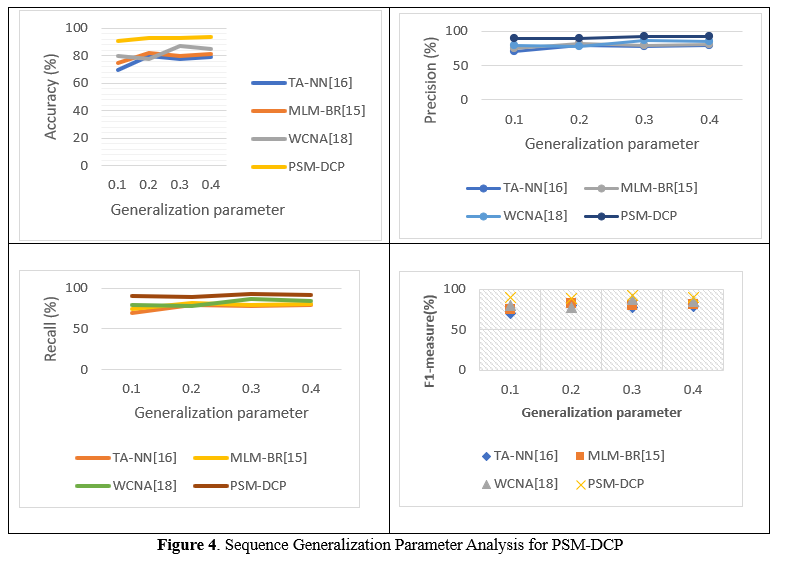
5. Conclusion and Future Work
The studies have showed encouraging results when they used a behavioral pattern mining technique to estimate Rocket League players' abilities, more especially the Player Skill Modeling using Data-Centric Patterns (PSM-DCP) strategy. By successfully tackling difficulties in skill shot recognition, the PSM-DCP demonstrates its resilience in dealing with the specific features of each skill performance. The system's use in player modeling goes beyond only skillshot recognition. It might improve match-making algorithms, help game commentators, and even lead to learning systems that help players get better. This study demonstrates the flexibility and adaptability of PSM-DCP in solving complicated problems in the gaming industry, and it lays the groundwork for improving esports analytics using data-centric approaches. Possible directions for future research include honing the PSM-DCP strategy, seeing if it works for other esports games, putting more emphasis on real-time implementation, using deep learning or advanced neural network architectures, broadening the dataset to include more data, and forming partnerships with industry stakeholders and esports experts. The study provides valuable insights into Rocket League and lays the groundwork for future improvements in esports analytics. It also serves as a guide for researchers interested in studying the dynamic world of competitive gaming.
References :
[1]. Wong, Donna, and Yue Meng-Lewis. "Esports: an exploration of the advancing esports landscape, actors and interorganisational relationships." Sport in Society 26.6 (2023): 943-969.
[2]. Goh, Edward, Omar Al-Tabbaa, and Zaheer Khan. "Unravelling the complexity of the Video Game Industry: An integrative framework and future research directions." Telematics and Informatics Reports (2023): 100100.
[3]. Freitas, Bruno Duarte Abreu. "The Infancy of the Esports Industry as a Risk to its Sponsors." Scientific Annals of Economics and Business 70.3 (2023): 421-458.
[4]. Tan, Ryan. "Manipulating Game Design Elements To Explore The Influence Of Difficulty On Videogame Experiences." (2023).
[5]. Cascella, Marco, et al. "Envisioning gamification in anesthesia, pain management, and critical care: basic principles, integration of artificial intelligence, and simulation strategies." Journal of Anesthesia, Analgesia and Critical Care 3.1 (2023): 33.
[6]. Lautier, Jackson P. "A New Framework to Estimate Return on Investment for Player Salaries in the National Basketball Association." arXiv preprint arXiv:2309.05783 (2023).
[7]. Hartley, Simon. Peak Performance Every Time: Strategies for Confidence, Motivation, and Focus. Taylor & Francis, 2023.
[8]. Yassin, Amira Kadry. "Exploring Gamification Advertising and its Role in Audience Engagement." International Design Journal 14.1 (2024): 163-173.
[9]. Smerdov, Anton, et al. "AI-enabled prediction of video game player performance using the data from heterogeneous sensors." Multimedia Tools and Applications 82.7 (2023): 11021-11046.
[10]. Mohan, Naren, et al. "Measuring gaze behavior to characterize spatial awareness skill in Rocket League." 2023 IEEE Conference on Games (CoG). IEEE, 2023.
[11]. Payadnya, I. Putu Ade Andre, et al. "Designing area of circle learning trajectory based on “what-if” questions to support students’ higher-order thinking skills." Journal on Mathematics Education 14.4 (2023): 757-780.
[12]. Molavian, Rozhin, et al. "Artificial Intelligence Approach in Biomechanics of Gait and Sport: A Systematic Literature Review." Journal of Biomedical Physics & Engineering 13.5 (2023): 383.
[13]. Monsma, W. H. A framework for Notational Analysis in Rocket League Esports: Enhancing Competitive Performance through Data-driven Insights. BS thesis. University of Twente, 2023.
[14]. Kovalchik, Stephanie A. "Player Tracking Data in Sports." Annual Review of Statistics and Its Application 10 (2023): 677-697.
[15]. Ke, Yuhao, Ranran Bian, and Rohitash Chandra. "A unified machine learning framework for basketball team roster construction: NBA and WNBA." Applied Soft Computing (2024): 111298.
[16]. Ziyi, Zhang, et al. "Multi-agent deep-learning based comparative analysis of team sport trajectories." IEEE Access (2023).
[17]. Białecki, Andrzej, et al. "SC2EGSet: StarCraft II Esport Replay and Game-state Dataset." Scientific Data 10.1 (2023): 600.
[18]. Chessa, Alessandro, et al. "Complex networks for community detection of basketball players." Annals of Operations Research 325.1 (2023): 363-389.
[19]. Kleinman, Erica Michelle. Designing Process-Oriented Computational Assistance to Support Self-Regulated Learning in Complex Games. Diss. UC Santa Cruz, 2023.
[20]. Mountifield, Charles. "Sport Analytics: Graduating from Alchemy." (2023).